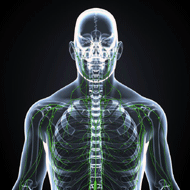|
Visceral
Lymphatic Balancing A Combination of Osteopathic
Techniques to Improve Patient Outcomes
|
 Many
physical therapists consider lymphatic drainage to be a
specialized set of techniques that do not factor into daily
practice. Many believe these specialized lymphatic
techniques only apply to patients with lymphedema and
involve extensive taping or complicated draping. These
common misconceptions have prevented many physical
therapists from incorporating specialized lymphatic work
into treatment. However, adding a principle-based treatment
approach to balancing the lymphatic system is easier than
commonly believed and may be the key to getting lasting
results for those difficult patients who are not responding
to the current treatment protocol.
Many
physical therapists consider lymphatic drainage to be a
specialized set of techniques that do not factor into daily
practice. Many believe these specialized lymphatic
techniques only apply to patients with lymphedema and
involve extensive taping or complicated draping. These
common misconceptions have prevented many physical
therapists from incorporating specialized lymphatic work
into treatment. However, adding a principle-based treatment
approach to balancing the lymphatic system is easier than
commonly believed and may be the key to getting lasting
results for those difficult patients who are not responding
to the current treatment protocol.
Another treatment myth is that physical therapy does little
to affect the visceral system. Other than radiate or mask as
musculoskeletal symptoms, visceral pathology is considered
the treatment realm of internal medicine providers. As in
the case of lymphatic drainage, visceral manipulation can be
effective in treating musculoskeletal disorders,
particularly those that have an overlooked visceral
component contributing to a musculoskeletal complaint.
The Lymphatic System
An important principle of osteopathic
treatment is Drainage Precedes Supply. This concept is based
on the understanding that tissues need a healthy inflow of
oxygenated and nutrient rich blood for cellular homeostasis
and repair. However, for tissues to receive this healthy
circulatory inflow, there must first be a properly
functioning lymphatic outflow to drain the tissues. The
system responsible for providing this drainage pathway is
the lymphatic system.
A properly functioning lymphatic system is critical for the
body to maintain homeostasis and regenerate tissue.
Specifically, the lymphatic system helps maintain normal
blood volume and pressure, helps rid the body of cellular
metabolic waste, and helps prevent excess accumulation of
fluid in and around tissues. Additionally, the lymphatic
system assists with tissue regeneration and supports the
immune system by removing excess fluid, debris, toxins, and
damaged cells from injured tissue.
If lymph circulation stagnates due to injury or infection,
tissues become congested and the ability of the tissue cells
to receive healthy blood is compromised. This leads to an
accumulation of cellular waste products in the tissues
causing pain, tension, and edema. Since “drainage precedes
supply,” a congested or impaired lymphatic system makes it
difficult for injured tissues to filter out metabolic waste
and receive nutrients and building blocks needed for repair.
To prevent damage and promote healing, this accumulated
waste and edema must be promptly removed.
The Visceral System
For the visceral system to maintain
health and homeostasis, each organ must also receive
unobstructed blood flow, balanced nervous system input, and
unrestricted energy flow. However, when the same principle
is applied to the visceral system, the overall health of an
organ is not only dependent on its inflow, but more
importantly, on its outflow. If lymph circulation stagnates
due to injury or infection, organs become congested and the
ability of the organ tissue cells to receive healthy blood
is compromised. This leads to an accumulation of cellular
waste products in the tissues causing pain, tension, and
edema. As previously discussed, to prevent visceral damage
and promote healing, this accumulated waste and edema must
be promptly removed.
Lymphatic Balancing
Lymphatic drainage
dates to the late 1800s when faculty at American School of
Osteopathy, the first osteopathic college in Kirksville,
Missouri, began research on distribution within the vascular
and lymphatic systems. In 1922, Frederic Millard, DO, a
student of A.T. Still University, published Applied Anatomy
of the Lymphatics which led the way for further research and
development of specific techniques aimed at treating the
lymphatic system. Inspired by Millard, Gordon Zink, DO,
expanded the concepts to include the Respiratory-Circulatory
model. This model emphasized the influence of fascial
restrictions on venous and lymphatic return and the
importance of creating pressure differentials in the
cavities of the body to encourage the ease of fluid flow.
From this early research, several treatment approaches to
manual lymphatic drainage emerged, including the Vodder
Method, the Chikly Lymphatic Drainage Technique, and the
Leduc Method. However, these approaches primarily focus on
treating Lymphedema making them applicable to a minority of
patients seen in physical therapy and leading to the
commonly held misconceptions mentioned earlier. Recently,
though, a treatment approach called Lymphatic Balancing has
incorporated techniques that can be easily applied to a wide
range of clientele within the orthopedic community.
Building off the principle-based concepts of osteopathy,
Lymphatic Balancing is a specifically designed curriculum
that applies specialized manual lymphatic drainage
techniques, originally designed to treat lymphedema, to the
orthopedic patient. Developed by Dr. Kerry D’Ambrogio, these
drainage techniques incorporate the use of gentle,
rhythmical pumping techniques to treat excess fluid or
swelling, fluid stagnation, or lymphedema in the cranium,
spine, rib cage, visceral system, and the upper (shoulder,
elbow, wrist and hand) and lower extremities (hip, knee,
ankle and foot). First developed by Earl Miller D.O., the
lymphatic pump is a manual technique that makes the use of
both long and short levers to encourage the healthy flow of
lymph. More importantly, these pumping techniques can be
easily integrated into a multitude of manual treatment
approaches without the need for special draping or taping.
It is a non-invasive approach in which the risk to benefit
ratio is exceptional.
Visceral Manipulation
Developed by Jean-Paul Barral, DO,
MRO(F), RPT, Visceral Manipulation is an integrative
approach to evaluation and treatment of the structural
relationships between the viscera and the musculosketal
system. Strains in the connective tissue of the viscera can
cause tension patterns to form through the deep fascial
network creating abnormal point of tension and leading to
congestion of the visceral lymphatics. Visceral Manipulation
removes these fascial barriers around the organs, which has
a direct effect on the musculoskeletal system by improving
posture, range of motion, and function, but areas of
lymphatic congestion can remain. Combining Lymphatic
Balancing and Visceral Manipulation not only improves
fascial tension around an organ, but also creates a better
environment for the outflow of metabolic toxins and the
inflow of nutrient rich oxygenated blood to promote quicker
healing.
Visceral Lymphatic Balancing
Visceral Lymphatic
Balancing (VLB) is an effective manual therapy treatment to
relieve congestion and remove accumulated waste and edema in
the organs to decrease pain, restore full function and allow
for optimal healing. The VLB procedure involves both short
and long lever manual pumping and drainage techniques to
simulate gentle, specific wave-like movements that stimulate
fluid motion and aid in the re-circulation of the venous and
lymphatic flow. These subtle manual techniques not only
activate lymph and interstitial fluid circulation, but also
stimulate the immune system and help balance the autonomic
nervous system.
Visceral Lymphatic Balancing 6 Step Treatment Approach.
1. Perform an Evaluation, including General and Local
Listening to identify and treat the visceral dysfunction
with Visceral Manipulation.
2. Balance the Transverse Diaphragms: Being horizontally
oriented, when restricted, these four diaphragms can impede
lymph, blood (artery or vein), nerve, and energy flow. To
ensure unrestricted fluid flow, the diaphragms must be
balanced.
3. Balance the Autonomic Nervous System (ANS): Since the ANS
controls microcirculation through vasoconstriction and
vasodilation of the lymph and blood vessels, it is important
to balance the autonomic nervous system prior to any
treatment.
4. Perform Lymphatic Balancing Specific Techniques: Perform
the appropriate LB technique sequence to promote lymphatic
flow in the affected organ.
5. Perform Lymphatic Balancing Supportive Techniques.
Perform supportive techniques to maintain and extend the LB
treatment effects. Active lymphatic pump exercises can
further address swelling and improve deep circulation.
Additionally, basic lymphatic taping can be used to provide
ongoing support and encourage continued drainage of the
treatment area.
6. Perform a Re-Evaluation: Perform following treatment to
measure change and determine further treatment progression.
Visceral Lymphatic Balancing is one of 5 Lymphatic Balancing
courses offered at the D’Ambrogio Institute (DAI). Courses
are specifically designed for the orthopedic patient and can
be taken in any order.
Lymphatic Balancing Upper Quadrant (LBUQ):
This course teaches a Local Treatment Approach to release
lines of tension and eliminate congestion in the lymphatic
system of the cranium, face, cervical/thoracic spine,
rib-cage, deep thorax, upper abdomen, and upper extremity.
Lymphatic Balancing Lower Quadrant (LBLQ):
This course teaches a Local Treatment Approach to release
lines of tension and eliminate congestion in the lymphatic
system of the lower abdomen, lumbar spine, pelvis, sacrum,
lower extremity, deep lymphatic, and deep abdominal region.
Lymphatic Balancing Total Body (LBTB): LBTB
is a Total Body Evaluation and Treatment Approach that
identifies and treats extraneous lines of tension, total
body lymphatic congestion, and imbalances in the diaphragms
and ANS.
Visceral Lymphatic Balancing (VLB1):
Specifically designed to complement Visceral Manipulation
treatment, this course teaches a Local Treatment Approach to
balance the transverse diaphragms and ANS, release lines of
tension, and eliminate congestion in the lymphatic system of
the thorax and abdomen
Cranial Lymphatic Balancing (CLB):
Specifically designed to complement Craniosacral Therapy,
this course teaches a Local Treatment Approach to balance
the transverse diaphragms and ANS, release lines of tension,
and eliminate congestion in the lymphatic system of the
cervical spine and cranium
For more information regarding Lymphatic Balancing, how it can benefit your
patients, and training seminars, please go to
Dambrogioinstitute.com.
Last revised: December 9, 2018
by Dr. Kerry D’Ambrogio, D.O.M., A.P., P.T., D.O.-M.T.P.
 Kerry
D’Ambrogio is a physical therapist, osteopath and
board-certified acupuncture physician. He is the president
and director of the D’Ambrogio Institute and Therapeutic
Systems, Inc., in Sarasota, Fla. He is the co-author of
Positional Release Therapy (Mosby). D’Ambrogio is a
graduate of the physical therapy program at the University
of Toronto (Canada), the osteopathic program at the Canadian
Academy of Osteopathy (Hamilton, Ont.), the John Wernham
College of Classical Osteopathy (Maidstone, England), and
the acupuncture program at the Academy of Chinese Healing
Arts (Sarasota, Fla.).
Kerry
D’Ambrogio is a physical therapist, osteopath and
board-certified acupuncture physician. He is the president
and director of the D’Ambrogio Institute and Therapeutic
Systems, Inc., in Sarasota, Fla. He is the co-author of
Positional Release Therapy (Mosby). D’Ambrogio is a
graduate of the physical therapy program at the University
of Toronto (Canada), the osteopathic program at the Canadian
Academy of Osteopathy (Hamilton, Ont.), the John Wernham
College of Classical Osteopathy (Maidstone, England), and
the acupuncture program at the Academy of Chinese Healing
Arts (Sarasota, Fla.).
 Many
physical therapists consider lymphatic drainage to be a
specialized set of techniques that do not factor into daily
practice. Many believe these specialized lymphatic
techniques only apply to patients with lymphedema and
involve extensive taping or complicated draping. These
common misconceptions have prevented many physical
therapists from incorporating specialized lymphatic work
into treatment. However, adding a principle-based treatment
approach to balancing the lymphatic system is easier than
commonly believed and may be the key to getting lasting
results for those difficult patients who are not responding
to the current treatment protocol.
Many
physical therapists consider lymphatic drainage to be a
specialized set of techniques that do not factor into daily
practice. Many believe these specialized lymphatic
techniques only apply to patients with lymphedema and
involve extensive taping or complicated draping. These
common misconceptions have prevented many physical
therapists from incorporating specialized lymphatic work
into treatment. However, adding a principle-based treatment
approach to balancing the lymphatic system is easier than
commonly believed and may be the key to getting lasting
results for those difficult patients who are not responding
to the current treatment protocol.



